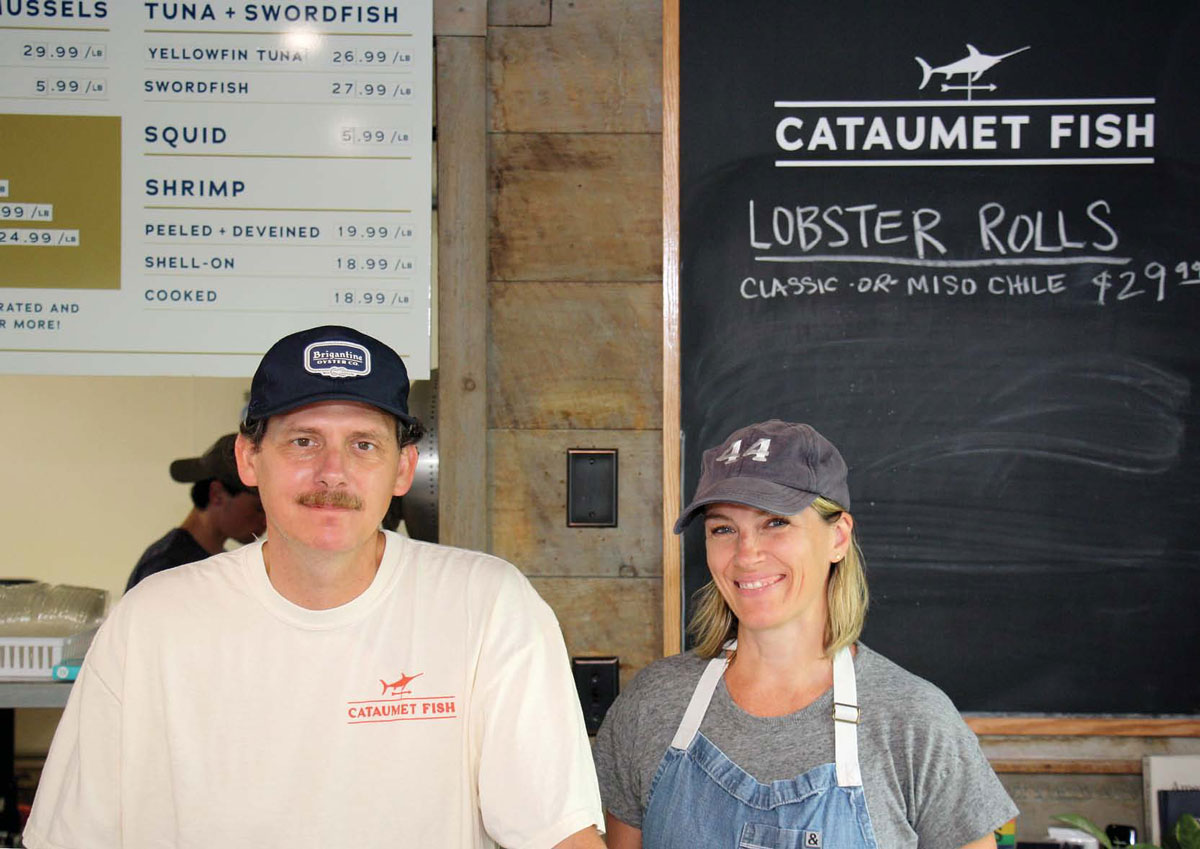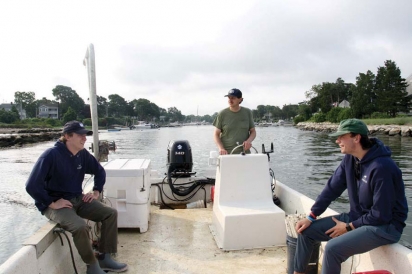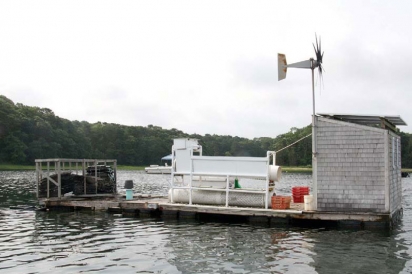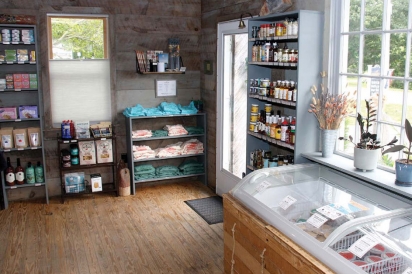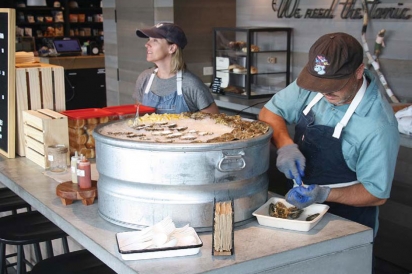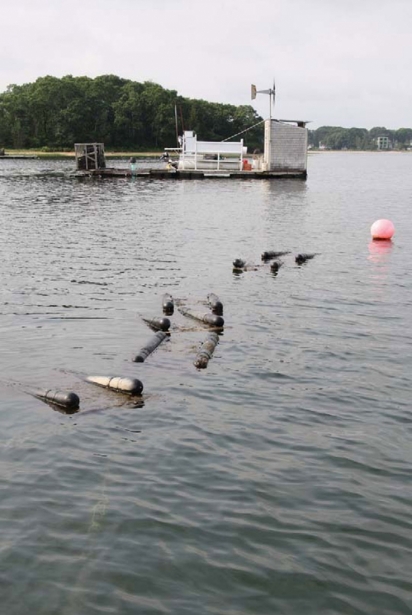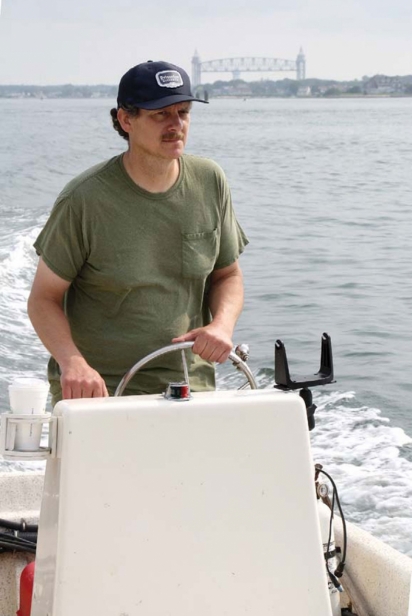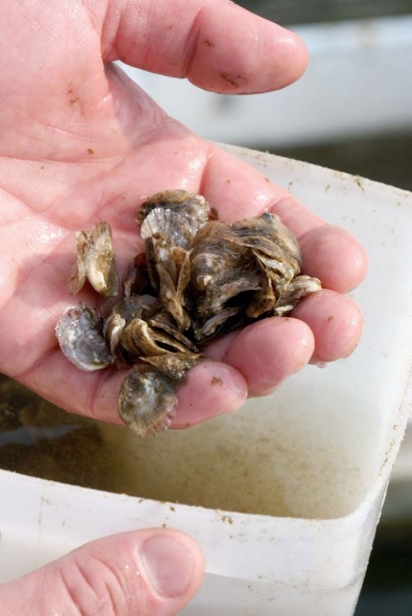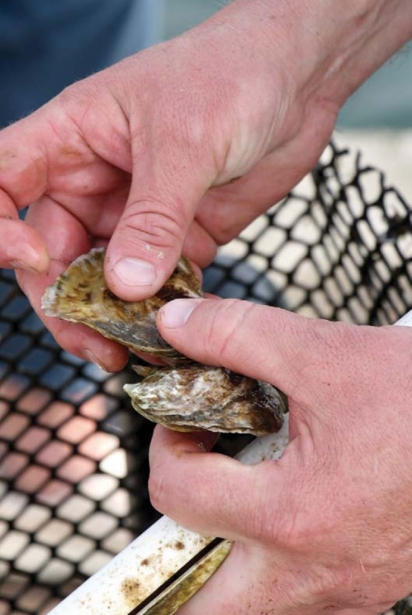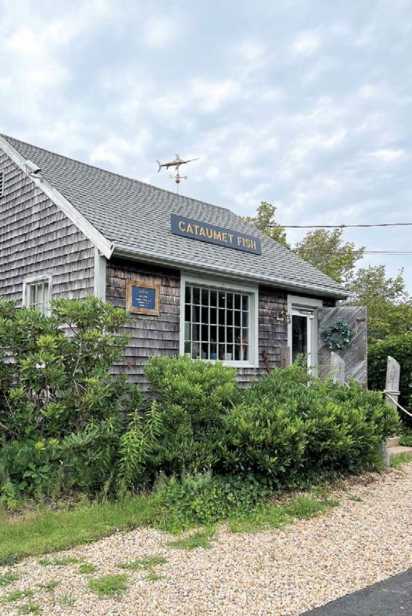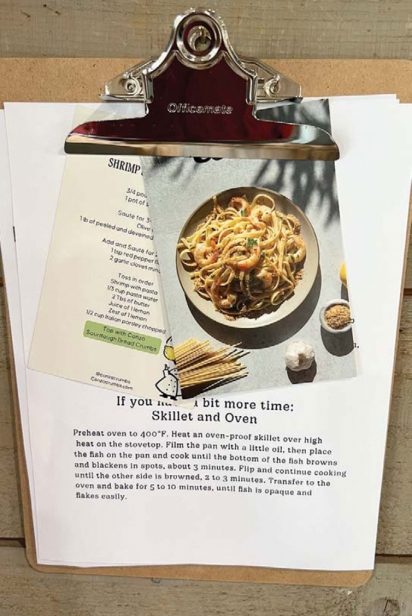Cataumet Fish: Curiosity Grew the Business
Pat Ross glides his Carolina skiff out of the mouth of the Pocasset River and into Little Bay. The strong summer sun works to burn off the early morning fog as he turns to the north. The destination is Monk’s Cove. There, tucked behind Toby’s Island, is home to Ross’ oyster grant, Monk’s Cove Oysters. Ross is giving a tour of the operation to two of his summer employees, Calvin Parker and Finn Bascio. That the pair are working at Ross’ latest venture, Cataumet Fish, goes to show just how far Pat and his wife, Jenny, have come with their burgeoning seafood enterprise since launching Monk’s Cove Oysters in 2012.
When edible CAPE COD first talked with Pat and Jenny back in 2014, they were just starting to find their way in the oyster growing industry. Three years prior, it all started with Pat and Jenny wondering what it would take to get an oyster grant in Pat’s hometown of Bourne. They approached the town about getting approval to build the farm. Since the town hadn’t had any working oyster grants in over twenty years, there was no permitting process to follow. “They told me to find a suitable site that would meet all of the state’s regulations, and they would put together a permitting process,” Pat remembers. As challenging as a regulatory process can be, trying to navigate it while it’s being created adds an entirely new level of challenge. Having a background working in governmental affairs, “regulatory process” didn’t send shivers down his spine like it would most prospective business owners. “I was comfortable with it,” he states.
The first site the pair found checked all the boxes. Massachusetts regulators were okay with the location, and there was only one waterfront home that could cause a fuss because of their view. “He [the homeowner] turned out to be very supportive,” Jenny adds. “I really think the public sentiment on oyster grants has changed.” The site, unfortunately, featured extremely difficult working conditions for any oyster farmer, let alone a pair of rookies. “It was completely unworkable,” Pat laughs, and Jenny picks up the story, “It was deep water at the head of Buzzard’s Bay, and the wind would kick up and turn the boat sideways. It was really hard to get on the gear.” The cages set twelve to fifteen feet deep were subtidal, so only the buoys marking the four corners of the grant were visible at any time. This certainly helped with any potential pushback from homeowners who tend to grumble about the sight of oyster cages as they become exposed at low tide.
At two millimeters each, the oyster seed (or spat) resembles a pile of coarse sand. The seed that first year was supplied to the Rosses by Skip Bennett, the owner of Island Creek Oysters. Pat recalls the conversation with a chuckle, “Skip gave us the seed and said, ‘OK, you’re going to kill most of these’.” Pat and Jenny (in unison), “and we did.”
The sheltered waters of Monk’s Cove turned out to be a much better location, ideal for both mollusk and man. As we approach, the upweller platform comes into view. “This is a total DIY job, that’s for sure,” Pat says as he ties off the skiff to the anchored dock he constructed. This is where oysters start their two-year journey from the seed Ross receives every June from Muscongus Bay Aquaculture in Maine, into the display case at Cataumet Fish or the raw bar table of Sea State Raw Bars + Catering, run by Jenny and Pat’s sister, Jessica Moerman.
“Not very photogenic unfortunately,” Pat offers. In the building world, there’s a phrase “form follows function”. A structure needs to be constructed to achieve its intended purpose(s) before aesthetics can be factored into the equation. The upweller is pumping along continuously. The PVC tumblers are ready to chip the edges of the oysters’ shells which will encourage the mollusk to grow a deeper cup to hold more of that delicious liquor. Stacks of oyster bags await this year’s lot. A shed for storage with three solar panels and a wind turbine atop the roof power the entire operation. For the purpose of growing oysters, Pat’s creation is a thing of beauty.
As the name implies, the upweller is a pump that brings the nutrient-rich water from below and into the boxes holding the tiny oysters. Perforated pipe pulls the water from the top of the boxes, drawing fresh water from beneath. The farm, managed by Pat’s boyhood friend from preschool, Andy Arch, has even begun to dabble in raising clams from seed in the same way. Instead of moving them into bags to grow out, Andy will cast the clams out into the muddy bottom of Monk’s Cove where they’ll be as happy as a…oh, you get the idea.
From spending their first season in the upweller, the oysters move to the floating bags nearby to be ready in the fall of their second season. Ross and Arch will move the oysters to the other side of Mashnee Island, just outside the channel leading to the southern entrance of the Cape Cod Canal, to finish and be available during the summer months when access to Monk’s Cove is closed to commercial harvesting. The cages here are adjacent to the ribs of a sunken barge that wrecked while constructing the Cape Cod Canal over one hundred years ago.
“We didn’t want to grow a ton of oysters and have this big bar,” Jenny claims. “We just wanted to grow the perfect oyster.” With each microclimate being different, locations – and resulting flavors – can be vastly diverse mere yards away from one another. “Even oysters in top floating bags will taste different than ones in bottom cages fifteen feet below,” Pat further explains.
Oyster farmers can’t sell their own product. They must sell to a dealer, who, in turn, sells the oysters to restaurants, markets, etc. Regulators relaxed the rules for scallop fishermen to sell their catch directly from the boat during the COVID pandemic. Oyster farmers weren’t as lucky, so the Rosses began to inquire about getting a dealer permit of their own. Triple wash sinks, refrigerated vehicle, and copious amounts of record keeping are needed to adhere to the Hazard Analysis Critical Control Point (HACCP) guidelines set by the U.S. Food and Drug Administration.
A decade on, the Rosses had attained a process that’s repeatable in growing their oysters. Their dealer’s permit in hand, they began to sell to two Boston restaurants and grow their wholesale business, when a friend mentioned that Cataumet Fish was for sale. The much-loved fish market opened back in 1981 by Peter Fisher. He grew to open two other locations over the years, but in 2022 he was looking to sell the sole surviving original location on Route 28A in Cataumet. A few more people suggested that Pat and Jenny should buy it, and it got the Rosses thinking. “It was actually similar to when we opened the oyster farm,” Pat recalls. “It was a curiosity like ‘huh? this place is for sale, and wouldn’t it be nice…’” Once again, Jenny adds, “We saw it for sale, but there’s no way. We both still had our other jobs. It seemed like a really big leap.”
Pat and Jenny did then what they’d done before. Ask questions and find out what it would take to pull off this next chapter: Research the funding possibilities and reach out to Fisher directly. “He knew me and my family because I grew up with his son,” Pat says. That connection helped pave the way for the Rosses to take over Cataumet Fish in March of 2022. A “light renovation” was needed, and the pair hustled to get it done by the summer season. With barely a moment to spare, Cataumet Fish was back up and running Memorial Day two months later. And did they ever hit the ground running. “We opened the doors, and uh! It was like drinking from a fire hose!” Jenny laughs. “Our customers were so great. They were so supportive, and thankful that we were staying a fish market.”
Oyster farming was a “learn as you go” experience. The most common response they would get from established farmers to their questions was, “It depends.” Because of those microclimates, every site had its own unique set of circumstances that required a unique set of solutions. What about running a retail fish market? Where were the Rosses to turn? Luckily for them, they didn’t have to look far. Pat explains, “We were lucky to have all of these kids come back who had worked here for several summers. They just came in and did their jobs as they’d done them before.” In a way, Pat and Jenny learned the ropes through their employees. “They were great kids,” Jenny remembers.
Step into Cataumet Fish today, and you’re likely to hear, “Hey Pat”, “Hi Pat”, “Morning Pat” as regular customers file in for their fish. At the end of that first summer, when the rest of the staff went back to school, the number of employees shrank to two: Pat and Jenny. It was like that all winter, and they quickly were on a first name basis with their following. “For eight months, whenever someone walked through the door, it was one of us,” Pat chuckles. Customers, while chatting with Pat and one another, can peruse the shelves of locally-made small-batch items that make for the perfect addition to any seafood appetizer or entrée. Clipboards with different recipes hang from a barnboard-covered wall for those looking for inspiration.
When it comes to supplying the market with locally-caught fin and shellfish, a dozen fishermen, oystermen (because customers like a variety of oysters), and clam diggers stop by with their daily catch. Scheduling can be a challenge. Some days are more bountiful than others when chasing fish. The way Pat and Jenny keep track of when certain fishermen might appear is surprisingly simple: ice. In the the back of the market is a large, insulated room where ice falls continuously from an ice maker through a scuttle hole in the ceiling. A massive six-foot mound of ice fills the room. It’s more than enough ice to keep the market’s fish stock fresh, and Pat shares the wealth. “Ice is expensive,” he plainly states. Pat offers fishermen free ice to take aboard with them when they head out to sea. “We know that we’ll probably be seeing them the next day. They appreciate it (the free ice). They could sell their entire catch to one dealer and be done if they wanted, but they’ll come by and sell us a portion. It’s an extra step for them,” Pat points out.
Their next move is to do a much more extensive renovation, if and when Cataumet Fish’s liquor license comes through. “This is another case of us talking about it, but we had no earthly idea about what went into liquor licensing,” Pat states. So, more questions, more research, and they put together a license application with the goal of expanding the retail area, and having a small bottle shop to feature natural wines that would pair well with the seafood in their cases. The Town of Bourne approved the application, but a rather large market chain’s Bourne location is appealing the decision and, until the appeal process is exhausted, the David vs. Goliath battle will continue, and the bottle shop is on hold.
Jenny, while still maintaining her full-time job as Concept Director at New Balance, manages to run Sea State Raw Bars + Catering with her sister-in-law, Moerman, on the weekends. This past summer, the duo was hired for weekly pop-up raw bars at AutoCamp, a resort featuring Airstream trailers in Falmouth. Sea State also has a food truck for slightly larger affairs.
What’s next? Scaling up Monk’s Cove Oysters and expanding the offerings at Cataumet Fish. In the more immediate future, Pat’s excited to start dry aging fish this winter. More commonly thought of as a technique for beef, dry aging fish has been used in Japanese culture for centuries. It unlocks complex flavor profiles in the fish, and Pat can’t wait to turn local palates on to the taste.
No idea, no process, no challenge seems to be insurmountable to this couple. What started with Monk’s Cove Oysters has now grown to include Cataumet Fish, Sea State Raw Bars + Catering, and six-year-old son Oscar, who’s champing at the bit to pitch in at the market. The curious minds of supporters wonder where they’ll turn next. The world may be their oyster, but the oyster is no longer their world.
Along with being co-publisher of Edible Cape Cod with his wife Cori, Larry Egan is a New England Associated Press award-winning writer and commentator and host of the talk show The Handyman Hotline on Saturdays from 1-3 pm on 95.1 WXTK-FM. He can be found most afternoons on the trails of Cape Cod being worn out by their Portuguese Water Dog, Archie.
Cataumet Fish | Sea State Raw Bars + Catering |
Monk’s Cove Oysters
1360 Route 28A, Cataumet
508-392-9678
seastatefoods.com
Facebook @Sea State Foods; Instagram #seastatefoods


